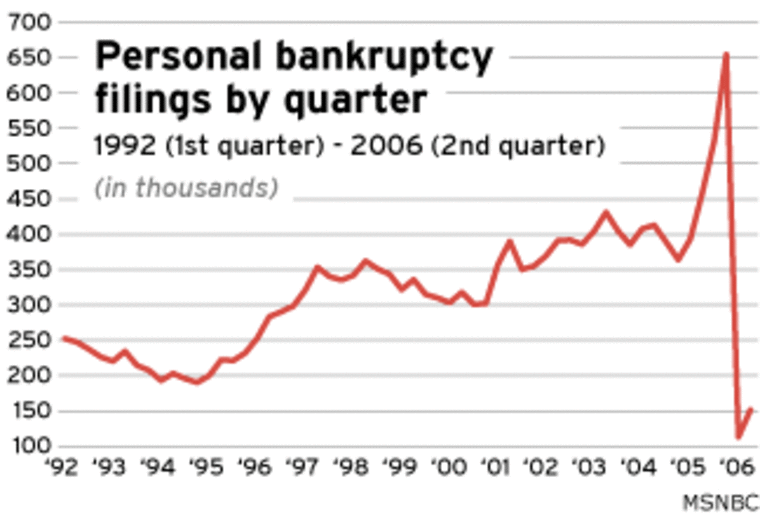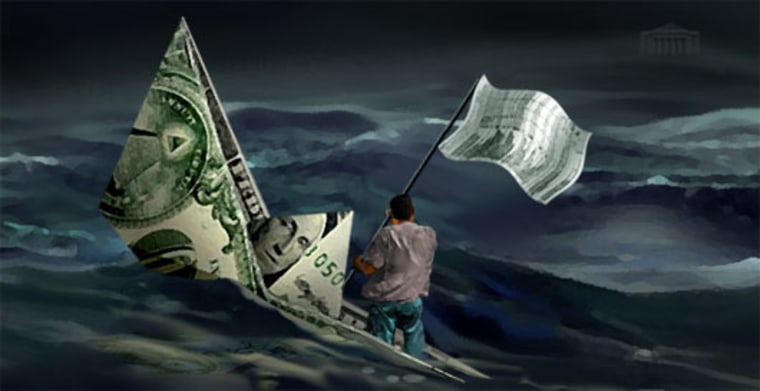A year after enactment, it remains unclear how many abusive bankruptcies the Bankruptcy Abuse Prevention and Consumer Protection Act of 2005 (BAPCPA) has actually prevented. But it appears that if the legislation was designed to provide additional protection to consumers, financially-strapped Americans may have no further need for enemies.
Bankruptcy filings for the twelve months since BAPCPA’s enactment are dramatically lower—475,000 compared to the roughly 1.45 million of recent years according to the latest data from Lundquist Consulting of Burlingame, Calif. But not even the American Bankers Association (ABA), which backed the legislative changes, is celebrating yet.
“We knew [the rate would drop] immediately after enactment and expected it to increase throughout the year,” says Laura Fisher, a spokesperson for the financial services industry group. She says it is still too early to tell what BAPCPA’s long-term impact on the filing rate will be. The ABA expects bankruptcies will eventually level off below the recent average.
Bankruptcy attorneys are skeptical that will happen. As a group they expect filings to return to pre-BAPCPA levels during 2007, according to a recent industry survey. But everyone agrees BAPCPA disrupted the short-term trend in filing. The plummet in filings this year follows a dramatic surge in 2005. Consumers, fearful of losing out on more favorable treatment, opted for pre-BAPCPA bankruptcy instead of waiting to see if they could address their problems outside of bankruptcy protection. Ironically, their preemptive actions were exactly what BAPCPA attempts to prevent — filing before absolutely necessary.
But many consumers also feared they would not be able to file at all once it the law changed.
A frequently misunderstood law
“A big misperception was and continues to be that the new law abolished bankruptcy,” says David Skeel, scholar-in-residence at the American Bankruptcy Institute, an independent research group headquartered in Washington, D.C. “It did not. We did not return to the days of debtor’s prison. What the Act did was make the filing process harder.”
Harder not just in terms of requirements, but in also in that filing became harder to afford.
That too is an irony of BAPCPA. “Because of the increased filing costs and attorney fees, you could conceivably be too poor to file for bankruptcy,” observes Skeel.
“Individuals are paying about twice as much in legal fees [since the work required of attorneys increased substantially] and filing fees have increased fourfold,” says Amy Boohaker, a bankruptcy attorney in Sarasota, FL. “People who are already broke are bearing the brunt of BAPCPA’s administration costs,” she adds.
But according to Fisher, the courts do have the discretion to waive some fees if warranted.
Still, it is not surprising do-it-yourself filings are on the rise. But pursuing the do-it-yourself route has also gotten much harder and riskier.

“People do not realize they now need to go through credit counseling before they can even file,” says Skeel. Skipping this step can result in a denial.
There are also stricter documentation and bookkeeping requirements. “The consequence of messing up the filing, submitting incomplete papers or missing a deadline is having the case thrown out," says Albin Renauer, co-author of How to File for Chapter 7 Bankruptcy. He says pre-BAPCPA there were opportunities to correct innocent mistakes.
Then there is the means test.
Renauer finds many consumers think if they fail this the test, they cannot file at all. They can, just not under the rules known as Chapter 7. This is the filing status presumed to be the most abused since it discharges a debtor from most of their obligations. BAPCPA was designed to discourage Chapter 7 filings in favor of Chapter 13 filings, which provide more relief to creditors.
The test’ determines whether a filer has the means — income or assets — to work out a repayment plan with creditors. If they do not, they may proceed with a request to file under Chapter 7, otherwise they need to file under Chapter 13. It is not a straightforward calculation, which is why Renauer created a free online calculator to help people understand their options—and that they still have options.
While the means test is key to reducing abuse under BAPCPA, according to a recent member survey conducted by the National Association of Consumer Bankruptcy Attorneys, so far less than a third are seeing increased Chapter 13 filings versus Chapter 7, as they say the majority of Chapter 7 filings appear legitimate and nonabusive in intent.
While the ABA feels the percentage of filings that are Chapter 7 versus Chapter 13 will be the best measure of the effectiveness of BAPCPA in reducing abusive filings, Fisher says it is too early to draw conclusions, especially given last year’s distortion of the numbers.
Bankruptcy's wide reach
For Boohaker, the biggest misperception surrounding bankruptcy remains what she asserts led to BAPCPA to begin with — that bankruptcy is a lifestyle choice overspending consumers use to absolve themselves of debt obligations so they can spend anew.
“It is a much more complex issue,” says Boohaker. “The people I see do not want to be in my office. Many find it humiliating.” Nor, she asserts, are they there because of overspending. More typically, she says, any excessive use of credit occurs after a catastrophic event like a divorce, job loss or medical issue sends them scrambling to pay bills.
“People [in financial trouble] often think their ship is about to come in — they accept offers of credit to tide them over assuming they will have a new job soon or the divorce will be settled quickly or the insurance company will reconsider and pay the hospital bill. When the ship does not materialize, they are too far in debt to get out,” she explains.
“And with or without BAPCPA, people are still going to have these events,” observes Renauer.
“With many people living paycheck to paycheck, regardless of how large that paycheck may be,” says Boohaker, “many are just one catastrophe away from being in the same position as my clients.”
Boohaker, who is also a certified financial planner, emphasizes the difference between working through unanticipated downturns and plummeting into a spiral of debt may be found by obeying the first commandment of financial planning: Maintain an emergency cash reserve equal to three to four months of living expenses.
ABA’s Fisher says BAPCPA did not target those driven into bankruptcy by job loss, medical bills or divorce. “It is aimed at the five to ten percent of filers who use it as a financial planning tool, who are spending and then filing out of convenience. The point was to make sure bankruptcy is not as good a deal for them anymore.”
But Boohaker, who deals with the other ninety percent of bankruptcy filers impacted by BAPCPA, questions whether it was the proper response. She suggests educational programs on the proper use of credit; planning for setbacks; and evaluating mortgage and credit offers may have been more appropriate. It might also stand a better chance of significantly reducing bankruptcies than increasing the hassle and expense of filing for them will.
